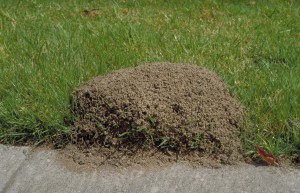By: Paul Schattenberg, Texas A&M AgriLife Communications
AgriLife Extension expert: Treatment depends on mound location, situation

People in South Central Texas and other parts of the state are seeing more fire ant mounds after recent rains, said Texas A&M AgriLife Extension Service entomologist Molly Keck. (Texas A&M AgriLife Extension Service photo by Dr. Bart Drees)
SAN ANTONIO – The recent rains have brought fire ants closer to the surface, both literally and as a matter of concern for area property owners, said a Texas A&M AgriLife Extension Service expert based in San Antonio.
“Rain doesn’t necessarily make fire ants more abundant,” said Molly Keck, AgriLife Extension entomologist and integrated pest management program specialist for Bexar County. “They were always there; they just weren’t as noticeable. When it rains, the ground becomes saturated and the fire ants move their colonies higher, giving some people the impression there are more of them than there were during dry months.”
Keck said unless homeowners have been treating regularly, it’s a safe assumption they already have or will be getting at least one fire ant mound in their yard.
“I have found mounds when weeding my garden, in my vegetable beds, along the sidewalk, next to my newly planted fig tree and in the middle of the yard,” Keck said. “They are huge, ugly, and look fairly ominous.”
Keck said there are many options for fire ant control, but the best option for control often depends on the location of the mound. She said some of the most common situations, along with her suggestions for control, are:
— Fire ants in vegetable gardens: There are limited options for control here, so if you are treating with a pesticide, be very careful to read the label to make sure what you are using is safe for use around vegetables. Boiling water and oils will work, but depending on how close that mound is to the plants, you may kill some vegetable roots. “I suggest products containing spinosad as either a drench or bait, as it is labeled for use in vegetable gardens,” Keck said.
— Fire ants without visible mounds: Keck said baits are definitely the way to go here. If you can’t see the mound, you can’t drench it properly. Ants take baits back into the nest and feed them to the other ants, including the queen. Baits may take up to two weeks to work, so be patient.
— Fire ants in yards: Treat individual mounds and follow up a couple of days later with a broadcast bait. You will eliminate or at least reduce the size of the mounds you treat individually, and the bait will help keep the populations down and knock out the mounds that you didn’t see.
— Immediate treatment: If you’re having a party or outside gathering in a few days, or need to treat quickly for some other reason, Keck suggested using broadcast granules or individual mound treatments or both. If the ant population is really dense, treat individual mounds with a liquid drench or a dust labeled for fire ants. Then use a broadcast granule treatment to provide a barrier to prevent new mounds from popping up, as well as to treat any unseen mounds.
— Long-term fire ant management: If you want to avoid “emergency” fire ant treatments, it’s best to have a treatment regimen and to use baits as the preferred method. If your fire ant populations are fairly low to begin with, you can treat every six months. Treatments in the fall may result in no ants in the spring, in which case you can eventually drop back to once every 12 months. If the mounds are large and fire ant populations are dense, you may need to treat once, then again in six to eight weeks. Then you can return to an every-six-months routine.
As with all pesticide use, she said, read the label first, apply only what is recommended and wear protective clothing during application.
“Overall, I think the most effective and lasting results come from the use of fire ant baits,” she said. “Baits are food to the ants, so they are attracted to it and take it back to the mound and share it with the others. This means putting less pesticide into the environment while getting better long-term results.”